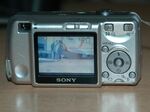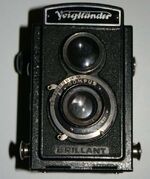(→Measurement: -spell corrected) |
(→Lens) |
||
| Line 11: | Line 11: | ||
A camera for ''general'' use consists of an enclosed hollow with an opening [[aperture]] at one end for [[light]] to enter, and a recording or viewing surface for capturing the light, at the other end. |
A camera for ''general'' use consists of an enclosed hollow with an opening [[aperture]] at one end for [[light]] to enter, and a recording or viewing surface for capturing the light, at the other end. |
||
| − | === |
+ | ===Lens=== |
| − | The |
+ | The lens generally is used to admit reflected image from the object. This has an aperture mechanism built in, to vary the light which generally can be adjusted manually. |
===Viewing plate=== |
===Viewing plate=== |
||
Revision as of 02:41, 17 October 2011
A camera is a device used to capture images, either as still photographs or as sequences of moving images (movies or videos).
Types
Cameras of different types are used in different professions or on different occasions. Different types of cameras are also used by different professionals, such as engineering, medical and by ordinary people.
How operates(with spectrum light)
Cameras work with the light of the visible spectrum or with other portions of the electromagnetic spectrum.
Consists of
Box
A camera for general use consists of an enclosed hollow with an opening aperture at one end for light to enter, and a recording or viewing surface for capturing the light, at the other end.
Lens
The lens generally is used to admit reflected image from the object. This has an aperture mechanism built in, to vary the light which generally can be adjusted manually.
Viewing plate
This is a ground glass plate at the opposite end of the lens.
After viewing to set the correct focus and the time required for exposure, for the speed or the sensitivity of the particular film or plate to be used, the plate is replaced by sensitive plate or cut film.
Aperture
The diameter of the aperture of the lens is often controlled by a Diaphragm mechanism, but some cameras have a fixed-size aperture.
Use by different professional people

Sony digital camera-Image view

Sony digital camera-lens open
Use by ordinary people
Few years back cameras used to come with films for capturing light. These films have to be processed and printed, generally in the shops, which used to take time and money.
The present day cameras have gone digital in all walks of life. In digital cameras, generally, the aperture adjustments and focus are made automatically by adjusting a wheel, clearly marked of the scene. The lens adjusts itself automatically.
The digital cameras are rated in Mega pixels (more the Mega pixel, clarity is higher and costlier it becomes). This shows the clarity because of CCDs on the viewing screen.
The printing can be done at home with a printer and PC.
Movie cameras have also gone digital as well, with recording on tapes or CDs direct with subsequent loading to other CDs by use of PCs or lap tops.
For use by engineering profession
Cameras may capture many images in sequence. Those designed for single images are still cameras. However these categories overlap, as still cameras are often used to capture moving images in special effects work and modern digital cameras are often able to trivially switch between still and motion recording modes.
A video camera is a category of movie camera that captures images electronically using digital technology, on tapes or on CDs.
This technique with camera is used to analyse vibrations, movements of parts etc.
For medical profession
Doctors use cameras almost in all their professions today. These cameras generally are of different type, compared to what are used by engineers and other commons.
For examinations
The cameras used by doctors generally are of digital type with light being transitted via a glass fibre. This glass fibre has the advantage that light bends (which we studied in schools that light always travels in straight line) and follows the bent fibre to come to the viewing plate or image monitor. Doctors can view the monitor or send it to a printer.
For minor operations they need not make cuts in the skin. Instead they can make holes and see the same on monitors for any corrections.
Focus
Due to the optical properties of photographic lenses, only objects within an exact range of distances from the camera will be reproduced clearly. The process of adjusting this range is known as changing the camera's focus. There are various ways of focusing a camera accurately. The simplest cameras have fixed focus and use a small aperture and wide-angle lens to ensure that everything within a certain range of distance from the lens, usually around 3 metres (10 ft) to infinity, is in reasonable focus. Fixed focus cameras are usually inexpensive types, such as single-use cameras. The camera can also have a limited focusing range or scale-focus that is indicated on the camera body. The user will guess or calculate the distance to the subject and adjust the focus accordingly. On some cameras this is indicated by symbols (head-and-shoulders; two people standing upright; one tree; mountains).
Certain cameras known as Rangefinder cameras allow the distance to objects to be measured by means of a coupled parallax unit on top of the camera, allowing the focus to be set with accuracy.
Measurement
The following notations are used, generally, in photography.
- F is the focal length of the lens.
- f is the f number. This is a plain number only.
- D is the diameter of he lens or max opening the aperture.
- f =f/D; The formula for calculating the the aperture opening. This number is generally marked on the lens periphery.
Type of cameras
Sighle lens reflex
Single-lens reflex cameras allow the photographer to determine the focus and composition visually using the objective lens and a moving mirror to project the image onto a ground glass or plastic micro-prism screen.

Voigtländer Brillant twin-lens reflex camera.
Twin lens reflex
Twin-lens reflex cameras use an objective lens and a focusing lens unit (usually identical to the objective lens) in a parallel body for composition and focusing. View cameras use a ground glass screen which is removed and replaced by either a photographic plate or a reusable holder containing sheet film before exposure.
Modern cameras often offer autofocus systems to focus the camera automatically by a variety of methods.
Exposure control
The size of the aperture and the brightness of the scene controls the amount of light that enters the camera during a period of time, and the shutter controls the length of time that the light hits the recording surface.
Equivalent exposures can be made with a larger aperture and a faster shutter speed or a corresponding smaller aperture and with the shutter speed slowed down.